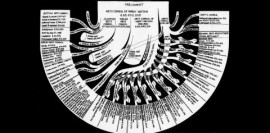Contents include: Artists, arts policy and funding: ‘A fair share?’ and ‘Understanding Turning Point’ are two new reports commissioned by a-n that aim to demystify the environment for contemporary visual arts practice; in ‘A preoccupation with cultivation’, Elizabeth Wewiora looks […]
James Rigler, Chatsworth Table, ceramic, marble, wood, steel, gold leaf, rope, 2011. Courtesy: Chatsworth House
In her report on Turning Point, Phyllida Shaw unwraps the ‘what’s what and who’s who’ of this major strategy for England, to support discussions on greater participation by, and development for, artists within it.
Is there enough funding going to individual artists and are the application processes user-friendly? These were questions a-n set out to answer in the fourth issue of what was then Artists Newsletter in 1980. Now, thirty one years later, we asked Dany Louise to do this research again, examining the current state of play for grants to individual artists as offered by Arts Council England, Arts Council of Northern Ireland, Arts Council of Wales and Creative Scotland – including comparators of volumes of artists applying and success rates – and to ascertain whether a “fair share” has been getting into the hands of artists to develop their practice.
On the first weekend in October in over thirty venues across the London Borough of Lambeth, artists are opening their work spaces to the public.
In 2010 artist Jo Berry embarked on a period of research within the School of Biomedical Sciences at Nottingham University Medical School, alongside Tim Self and Dr Nicholas Holliday. Here they recount the experience of an artist working in a ‘live’ scientific research environment, and the ways that the two disciplines of art and science can benefit each other to a wider audience.
Current professional development support schemes for visual artists in the UK.
Online editor Richard Taylor interviews artists Maria Bojanowska, Sarah Rowles, Alice Ladenburg and Andrew Maclean about their approach to professional development in the early stages of a career in the arts.
Elizabeth Wewiora looks at allotment-based practice among contemporary artists.
A selection of projects, residencies and exhibitions taking place outside the big cities this autumn.
Now in its fourteenth year, Deptford X is counting down a programme of events that will build towards the Olympic and Paralympic games in 2012.
A run down of this month’s prizes and awards.
Emily Speed reports from Abandon Normal Devices (AND) – ‘a call to arms inviting anarchists of the imagination to propose striking perspectives on normality’.
News and updates on AIR’s strategies and activities designed to support professional artists within their practice and working lives.
Comings and goings of arts professionals.
New developments in the gallery sector.
Crafts Study Centre, Farnham
26 July – 1 October
Alex Murdin asks what is Localism and what effect it is likely to have on art practice in regional areas.
Auto Italia South East, London
25 – 28 August
There are two key things Nicholas Leverington mentions that I want to zone into.
ArtSway, Sway, New Forest, Hampshire
25 June – 29 August
Yorkshire Sculpture Park, Wakefield
16 July – 18 September
I have just finished my MA, before that I did a BA in Fine Art. I learnt about how to think rather than what to think, which would seem to be the main difference between vocational and academic studies.
As part of its ongoing mission to support contemporary visual arts practice, this month a-n publishes two reports in the feature ‘Artists, arts policy and funding’.
The Project Arts Centre, Dublin
8 July – 20 August




















